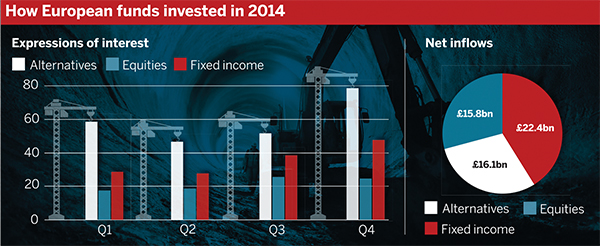European pension funds moved deeper into alternative investments last year as they sought fresh avenues of returns and liability matching in tricky market conditions.
Schemes have been convinced to broaden their investment horizons in light of persisting low yields and the squeeze on bank lending, opening doors to more esoteric investments.
Figures from FT service MandateWire (see graphic) showed interest in alternatives stretching its lead ahead of other key asset classes, receiving 79 expressions of interest in the final quarter of 2014 – more than equities (25) and fixed income (48) combined.
And consultancy Mercer’s ‘2015 Themes and Opportunities’ paper, released last week, said market conditions were leading investors towards “less familiar” investment opportunities where they could capitalise on their longer investment time horizons.
It said that while quantitative easing had injected liquidity into the equity and debt markets, the funding gap created by bank deleveraging still offered a source of return.
The report said: “Although an increasing volume of assets has been put to work in the private markets in recent years, we believe that the opportunity set in private markets is relatively attractive when compared with the listed markets.”

Some schemes are looking beyond alternatives’ more favoured sub-asset classes, such as property.
Last month the Pensions Infrastructure Platform announced plans to add a separate renewables fund to its existing infrastructure offering, to help generate long-term cash flows.
Agriculture investments are also receiving interest from funds looking to access steady long-term cash flows, but practical considerations remain a barrier.
The opportunity set in private markets is relatively attractive when compared with the listed markets
Mercer's 2015 Themes and Opportunities
Linda McAleer, consultant at Hymans Robertson, said the interest has come as a result of schemes becoming “disenchanted” with some other alternative asset classes, but she said investment has been limited so far.
She said farmland offers income and some inflation protection, and its low correlation with mainstream asset classes means it can help reduce overall portfolio risk. But she added: “The diversification benefits can be overstated as valuations are not marked-to-market.”
One scheme that increased its exposure to the asset class last year was Kingfisher Pension Scheme, which now has around 3-4 per cent of its return-seeking portfolio invested in agriculture.
Its pensions investment manager Matt Fuller said global farmland offers exposure to potential “equity-plus” type returns while having a low correlation to the main equity markets.
He added: “It has a number of facets, including exposures to characteristics of other alternative asset classes, such as commodities, real estate, private equity and infrastructure.”
Detlef Schön, group head of farm investments at asset manager Aquila Capital, said pension fund investors globally tend to prefer the real estate angle to farmland, with more than half choosing to lease out land to operators.
He said: “If you’re owning and operating a farm, it’s like owning a shopping mall and running the retail business in that shopping mall. So you need to be a good retailer and you also need to be a property developer and owner.”














